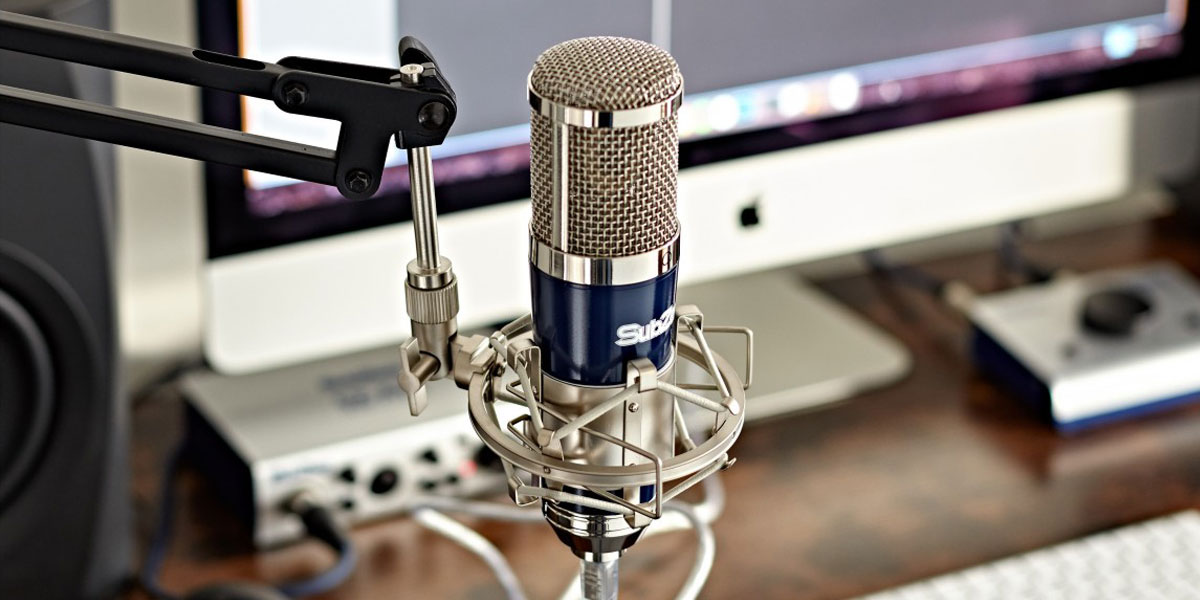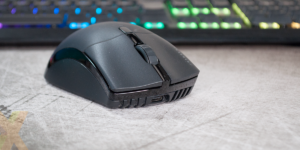
 Getting started in streaming is not an easy thing to do. Apart from building an audience, you will have to worry about getting a good webcam, a decent computer that can handle streaming, an internet connection and last but not least, a high-quality microphone.
Getting started in streaming is not an easy thing to do. Apart from building an audience, you will have to worry about getting a good webcam, a decent computer that can handle streaming, an internet connection and last but not least, a high-quality microphone.
But how should you chose which one is the best for live streaming if you know nothing about microphones? What is the difference between XLR and USB mics on a platform like Twitch?
Don’t worry, you won’t have to learn anything about mics because we have selected and reviewed the top ten microphones for streaming that you can currently get, just to make starting a streaming career easier for you.
The prices of these hardware in this list vary greatly, so we are completely sure you will the one that fits your budget and your expectation as well. There are premium and budget ones as well because we know not everyone has loads of money when they start streaming.
Feel free to browse around in the article, read the reviews and listen to the recordings. If you are looking for a certain product, just click on its name and it will take you right to the review.
Let’s jump on it!
Rode NT-USB – Simple Streaming Mic
 I don’t want to spend a lot of time on the physical overview of the Rode NT-USB because let’s be honest, they look very familiar. With the NT comes a carrying case which is made out of leather and a lovely sticker from Rode that says ” I love RODE”.
I don’t want to spend a lot of time on the physical overview of the Rode NT-USB because let’s be honest, they look very familiar. With the NT comes a carrying case which is made out of leather and a lovely sticker from Rode that says ” I love RODE”.
The mic itself stands on a rubber covered tripod stand, with a standard arm that lets you tilt it however you want. There is also a removable pop filter included in the package, which is a nice addition.
It comes with a pretty long USB cable. And by pretty long, I mean really long. It’s the longest USB cable I’ve ever seen actually. It’s nice if you have a lot of space to cover, but if you don’t it can get pretty messy.
On the front, there is a black grill that protects the condenser module. The Rode NT-USB has a cardioid pickup pattern, which means it is best for personal or close up use.
It connects with a full size USB-B cable, and on the right, you will find two dials one for adjusting the monitoring volume of it and one is a mixer dial that lets you control how much of the music you want to mix into your record.
The Rode NT-USB doesn’t have a gain knob, instead it u,ses an internal gain setting that works fairly well. Although some people love to mess with gain levels, for everyday users like streamers this is even better, because it simplifies things.
The Rode NT-USB is a great choice for beginner streamers, podcasters or gamers that want better audio quality for their teammates. Although it doesn’t have very advanced features like an XLR input or multiple pickup patterns, but it does have cool additions like the removable pop filter.
It is plug and play, just plug it in your computer and you are ready to go.
Sound Test:
Credits to: Podcastage
Audio Technica AT2035 – If you want quality on a budget
 This is an XLR condenser microphone which means it does require a phantom power to work. What does that means is that the AT2035 will not work directly plugged in you computer and it will also not work with an XLR to USB cable.
This is an XLR condenser microphone which means it does require a phantom power to work. What does that means is that the AT2035 will not work directly plugged in you computer and it will also not work with an XLR to USB cable.
The way you can connect it to your machine is by using a USB audio interface. You can control the gain and usually the monitoring volume on that interface as well.
With the microphone, you get a nice little shock mount, which is a great addition. The shock mount is all plastic, but it feels like relatively sturdy.
The package also includes a very nice leather padded carrying pouch.
Just like the other mics in this series, the build quality of this thing is pretty awesome. It has an all-metal construction a nice metal grill and some really nice substantial weight to it. Unlike the 2020, this does have to switches on the back, the first one is a 10 decibel pad, which helps when recording or streaming loud sounds, like a guitar amp, and the other is a bass low off, which just cuts a little bit of the low frequencies to help with low-frequency rumbles.
The Audio-Technica AT2035 has a cardioid pickup pattern, which means it is perfect for streaming or recording anything as long as you put it in front of the microphone.
In overall, the sound is fricking awesome on this thing. If you are gaming, and you are using a mechanical keyboard which has a lot of noise, it will be a very good option, although it is a bit expensive.
Sound Test:
Audio Technica AT2050 – If you want quality
 As for the beast before, you are going to need an audio interface as well, it isn’t simply just plug and record.
As for the beast before, you are going to need an audio interface as well, it isn’t simply just plug and record.
Just like with the AT2035, in the package, you are going to find a hard plastic shock mount, which is not that great of a quality, but it’s still sturdy. The leather padded carrying bag is a default it seems because there is one in the box of the AT2050 as well.
The build quality of this thing is really nice, the all-metal body gives it a modern yet minimalistic look. The metal mesh grill on it is very strong.
The AT2050 comes with multiple polar patterns. On the front, you can find a switch that lets you move between cardioid, omnidirectional, and bi-directional. On the back of the AT2050, you will also find a low cut switch, which again helps you cut out the lower frequencies of your recording. It has a pad switch as well.
The cardioid polar pattern is perfect for streaming or gaming.
The omnidirectional setting is great if you want to record a lot of ambient noise, entire meetings or people in a circle.
The bi-directional is great for podcasts, interviews as it records in front and on the back of the device.
This little thing is a very modern sounding microphone, it is relatively bright. If you are not going to use all of the polar patterns, I recommend looking into other cardioid mics, but if you, then it is a perfect choice.
Sound Test:
Audio-Technica AT2020USB+ – The most popular streaming microphone
 We can safely say that the Audio-Technica AT2020 is easily the most used cardioid microphone among streamers. keep in mind, that this is the USB+ version, not the XLR one.
We can safely say that the Audio-Technica AT2020 is easily the most used cardioid microphone among streamers. keep in mind, that this is the USB+ version, not the XLR one.
The AT2020 comes with a nice looking box, in it, you will find the mic itself, a long USB cable and a mount for the device. The desktop stand is pretty cheap quality, it often brakes. Usually, one or two legs just simply brake off. You get a carrying sleeve as well.
This Audio-Technica wonder is built well, just like the others. They all have a similar design and a nice metal construction.
On the front , you can find the grill, with a blue LED inside, that let’s you know if the mic is getting power or not. You find it annoying? Well unfortunately, you can’t turn it down.
There is a monitor volume dial, which helps you set the amount of mic/computer noise you want to hear. The other dial is just simply your headphone volume.
This is USB only and it is fully compatible with Windows and Mac. Because it is USB powered, you can just simply plug it in your computer/laptop and there you go.
It has a cardioid polar pattern only, but it is not a problem because it was made for this purpose. I have to mention that the pattern of it is a little wide, so if you have a huge room, it might pick up other noises, but with a noise gate, this can be easily fixed.
The frequency response is a little bit higher than the simple AT2020 USB version. Keep in mind that this is the USB+ version we are talking about here.
All around, this is a pretty nice sounding microphone, especially if you are planning on streaming.
Sound Test:
Blue Snowball USB Microphone – The low end
 Blue designs is a pretty popular name when it comes to mics. The Blue Snowball is compact and small, made for people that have smaller budgets. Keep in mind that this is NOT the Snowball Ice version, it is the original Snowball.
Blue designs is a pretty popular name when it comes to mics. The Blue Snowball is compact and small, made for people that have smaller budgets. Keep in mind that this is NOT the Snowball Ice version, it is the original Snowball.
The Snowball is a USB Condenser microphone that has two capsules in it. This allows the Snowball to switch polar patterns to Cardioid which only picks up noise in front of it, to an omnidirectional that picks up noise all around it.
In the box, you get the Blue Snowball itself, around six foot of USB cable, a 3 leg stand.
The build quality feels cheap because it is all out of plastic, and doesn’t feel durable. The stand does actually feel sturdy and nice although!
There is a ball joint on the mic, that allows you to slightly tilt it back and forth.
In the back, you will find the USB connector and a three-way switch. This switch lets you switch between Cardioid, Cardioid with 10-decibel Pad which lowers the volume about 10 decibels, and the Omnidirectional setting.
Unfortunately, the two capsules in the Snowball have to different tones and sounds. The cardioid sound more natural and full, the omnidirectional setting sounds more tiny, hollow and unnatural.
For this price tag, the Snowball is a pretty decent mic, but I wouldn’t use the omni setting at all, only the cardioid but for this price I wouldn’t expect any more.
Sound Test:
Razer Seiren – Elite Professional – The High end
 Ohh Razer. The brand that you automatically connect with quality in your head. And you are right, they create quality products, so is the Razer Serien Pro Elite.
Ohh Razer. The brand that you automatically connect with quality in your head. And you are right, they create quality products, so is the Razer Serien Pro Elite.
Just like the Blue Yeti, this has multiple capsules inside, which allows you to change the polar patterns.
The knob on the back allows you two change between four different polar patterns.
The very first is bi-directional, which picks up audio directly in front and behind it, this is good for interviews, and that kind of stuff. The second is cardioid, the most popular setting, which only picks up sound in front of it.
Next is omnidirectional, and the fourth is stereo which picks up audio on the sides of the mic.
What you get in the box is the Razer Seiren itself, it comes with a stand attached very similar to the blue yeti’s. It has a very nice looking braided USB cable, and an XLR cable that splits into two XLR’s so you will need to have at least two XLR inputs if you are going to use the XLR capabilities of the Seiren.
The design and quality of this thing is awesome. It has an all-metal body, and a nice metal stand that lets it stand firmly on your desk. Everything on the mic feels very well designed and built, just as we expected from Razer. Good job Razer!
On the front, you have an LED display, which lets you know what polar pattern you are using and the gain. Below that is your headphone volume knob and a mute button.
On the back we have two knobs, one changes between the four polar patterns the other is to control the gain of the microphone.
On the bottom, there is an XLR, USB output, and a regular headphone jack. It has a high pass filter as well.
The Razer Seiren Elite Pro sounds awesome in every polar setting. For this pricetag, we wouldn’t expect any less than it is providing, although some people think it is too expensive. I personally think it is completely worth the price.
Sound Test:
Blue Yeti USB Microphone – The High end
 Just like the Snowball, this is a great product as well. It is very similar to the Seiren, with its four patterns and full metal stand.
Just like the Snowball, this is a great product as well. It is very similar to the Seiren, with its four patterns and full metal stand.
In the box, you will find the Yeti, a USB mic cable and the stand which your mic will stand on.
The build quality of Blue Yeti USB is very good, it has a full metal body as well, and the stand it is on has a decent weight to it, which avoids knocking it over.
On the front we ,have the mute button, which lets you mute it instantly, and a volume knob which adjusts the monitor headphone volume.
On the back, we have a gain knob which increases or decreases your Yetis volume and below that is the pattern knob, which lets you choose between the four polar patterns, which is damn hard to turn actually.
On the bottom, you have the stand mount, a USB plug, and a 3.5 mm jack.
Everything on the Yeti feels sturdy and substantial except the volume knob and the gain knob.
The first pattern setting is the stereo setting. The second is the cardioid settings, which is the same setting you are going find on the microphones out there. The third, omnidirectional setting is great for conference calls, for orchestras.
The last setting is the bi-directional, it’s a good setting for interviews.
I highly recommend the Blue Yeti, it sounds awesome and the knobs allow you to fine-tune it to do exactly what you want with it. It basically has a setting for every scenario.
The only downsides are the two kinda cheap knobs, and that it is USB only. If you want an XLR version, you should get the Blue Yeti Pro.




